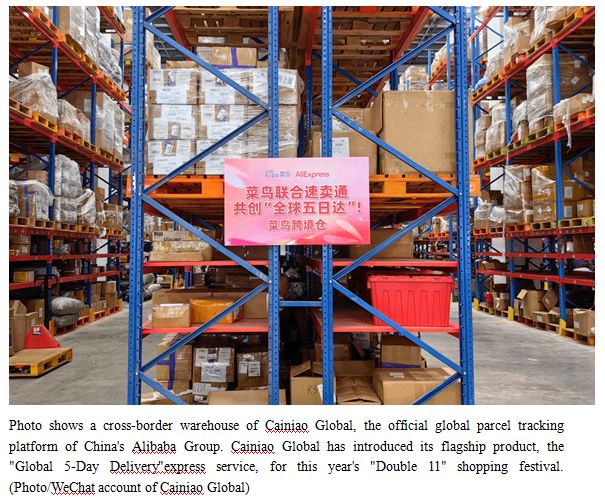By Jia Pingfan
In recent years, Chinese logistics companies have rapidly expanded their presence in overseas markets alongside the growth of China’s cross-border e-commerce platforms. They have entered markets in North America, Europe, Southeast Asia, the Middle East, and Central and South America, bringing digitalized logistics services and efficiency to their target markets while contributing to the global growth of foreign trade.
The world’s first live broadcast of cross-border logistics concluded on the evening of Nov. 4, 2023. Over the course of 48 hours, millions of people worldwide witnessed the complete journey of cross-border packages, from packing and sorting to shipping, consolidation, and loading onto international cargo planes.
Cainiao Global, the official global parcel tracking platform of China’s Alibaba Group, has introduced its flagship product, the “Global 5-Day Delivery”express service, for this year’s “Double 11” shopping festival. This service allows products sent from China to reach consumers thousands of miles away in just five days.
To achieve such fast delivery, Cainiao Global has made significant advancements in logistics technology and infrastructure. The company has established the country’s largest cross-border logistics park, equipped with intelligent sorting machines and an automated air freight center. Additionally, the use of a Boeing 747 widebody freighter further enhances the efficiency of the delivery process.
This year’s “Double 11” shopping festival has become a competition for faster delivery, receipt, and after-sales service for cross-border merchants and overseas consumers.
The “Double 11” shopping festival is China’s biggest shopping event. Since its inception in 2009, the festival has been known for its abundance of discounts, promotions, and offers. This year, instead of solely engaging in the price war, companies have prioritized providing high-quality services to their customers.
JD Logistics, the logistics unit of Chinese e-commerce giant JD.com, has been making consistent investments in overseas supply chain logistics facilities.
With nearly 90 bonded warehouses, overseas warehouses, and direct mail warehouses worldwide, JD Logistics has established a self-operated warehousing network in European countries like Germany, France, and the UK. Alongside expanding its warehousing capacity, JD Logistics Europe is actively collaborating with local service providers to enhance its last-mile delivery capabilities.
In 2022, China’s total social logistics reached 347.6 trillion yuan (about $47.89 trillion), marking a 3.4 percent year-on-year growth. With this growth, China’s logistics market has maintained its position as the global leader for seven consecutive years, solidifying its status as a logistics powerhouse.
The steady and positive growth of the Chinese economy has provided significant support for the rapid development of the logistics industry. The government’s increased support to promote economic growth, coupled with a rebound in consumer spending, has led to impressive economic performance in the third quarter.
Data released by the National Bureau of Statistics of China shows that the country’s GDP grew by 4.9 percent year-on-year between July and September this year, surpassing economists’ median forecast of 4.5 percent.
The growth of cross-border e-commerce has contributed to the expansion of China’s cross-border logistics industry. According to recent data from the Korea Customs Service, Koreans spent a total of 4.79 trillion won (approximately $3.65 billion) on cross-border online shopping from Q1 to Q3 this year, marking a 20.4 percent increase compared to the previous year. Chinese e-commerce accounted for 46.4 percent of this total, with sales amounting to 2.22 trillion won.
According to China’s Ministry of Commerce, the import and export volume of China’s cross-border e-commerce reached 1.7 trillion yuan from January to September this year, marking a year-on-year increase of 14.4 percent. China has established trade partnerships with countries worldwide, being one of the countries with the most comprehensive cross-border e-commerce ecosystem.
Overseas warehouses play a crucial role as key nodes for cross-border e-commerce and logistics. They serve as new foreign trade infrastructure and a vital platform for driving the high-quality development of foreign trade.
Xue Qun, head of JD Logistics International, recently expressed that JD.com plans to construct a comprehensive global supply chain logistics network in the coming three years. This network will encompass overseas warehouse networks, international transit hubs, distribution networks in foreign countries, and cross-border transportation networks encompassing key routes.
According to a news report by Quartz, China views logistics as a strategically important industry underpinning the efficiency and competitiveness of its economy. The Chinese government wants to take that a step further by building a modern circulation system that integrates flows of commerce, finance, transportation, and commodities.
According to the news report, one area where China has made significant progress in recent years is the number of overseas warehouses it operates via exporters or cross-border e-commerce firms with operations in international markets. These now number over 2,000, up from less than 100 in 2015, according to Chinese government figures.
Besides physical infrastructure like warehouses, China wants to cultivate a number of homegrown and globally competitive logistics firms, the news report said.



















